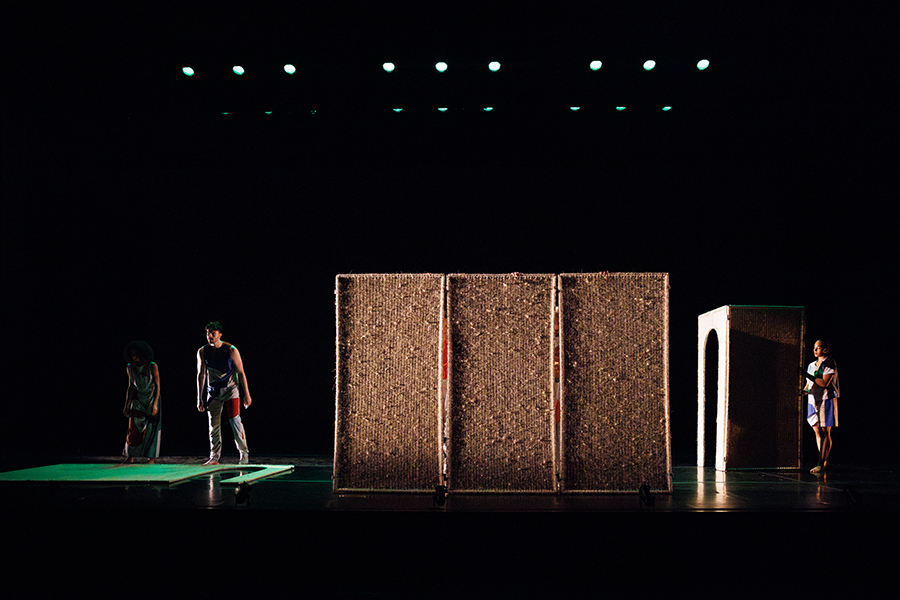
Sin duda, la riqueza de las creaciones culturales más conmovedoras, se manifiestan cuando se unen disciplinas diferentes, para producir importantes colaboraciones. En esta ocasión, el artista colombiano Mateo López y el coreógrafo australiano Lee Serle han unido sus talentos en la pieza teatral Time again, una obra que fusiona artes visuales y danza contemporánea para explorar los ciclos del tiempo y la transformación de la memoria. El proyecto, comisionado por la Trisha Brown Dance Company en asociación con Rolex, se presentó en el Joyce Theater de Nueva York del 29 de abril al 4 de mayo de 2025.
Undoubtedly, the richness of the most moving cultural creations emerges when different disciplines come together to produce meaningful collaborations. On this occasion, Colombian artist Mateo López and Australian choreographer Lee Serle have joined their talents in the theatrical piece Time Again, a work that merges visual arts and contemporary dance to explore the cycles of time and the transformation of memory. The project, commissioned by the Trisha Brown Dance Company in partnership with Rolex, was presented at the Joyce Theater in New York from April 29 to May 4, 2025.
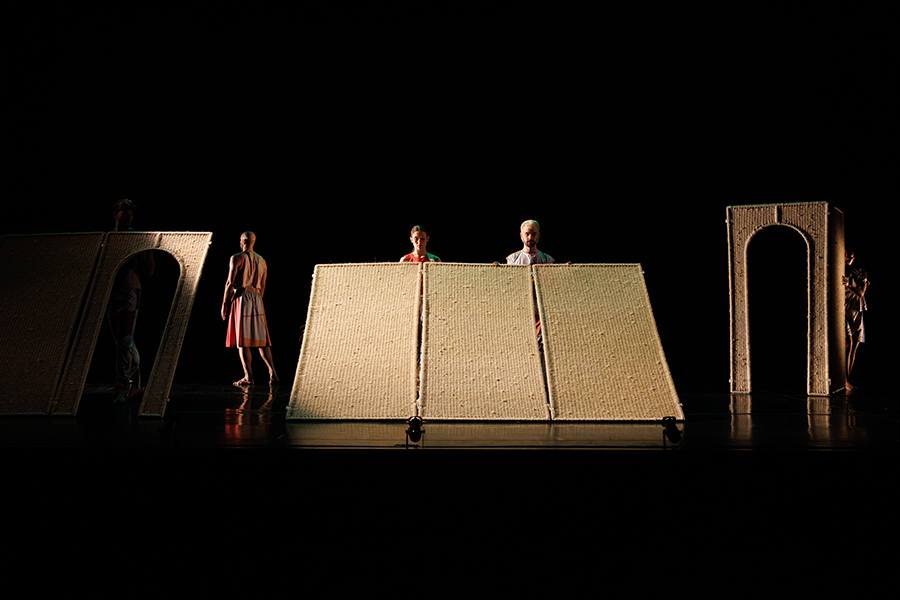
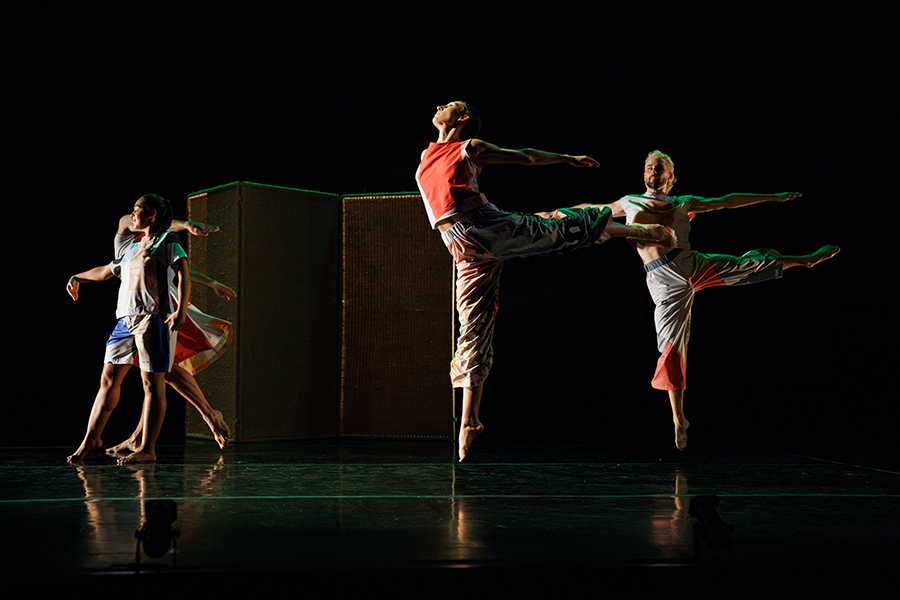
La colaboración entre Mateo López y Lee Serle tiene raíces profundas. Ambos participaron en la Iniciativa de Mentoría de Rolex: Lee Serle, fue protegido de Trisha Brown en 2010-2011, y Mateo López trabajó con William Kentridge entre el 2012 al 2013. Así, desde su primer encuentro en 2016, han desarrollado una relación creativa que se manifiesta en proyectos como la exposición “Undo List” en The Drawing Center de Nueva York, donde Serle interpretó físicamente las instalaciones de Mateo López, integrando movimiento y escultura en una experiencia inmersiva poética y potente.
The collaboration between Mateo López and Lee Serle has deep roots. Both participated in the Rolex Mentorship Initiative: Lee Serle was Trisha Brown’s protégé in 2010–2011, and Mateo López worked with William Kentridge from 2012 to 2013. Since their first meeting in 2016, they have developed a creative relationship that has materialized in projects such as the exhibition Undo List at The Drawing Center in New York, where Serle physically interpreted López’s installations, integrating movement and sculpture into a poetic and powerful immersive experience.
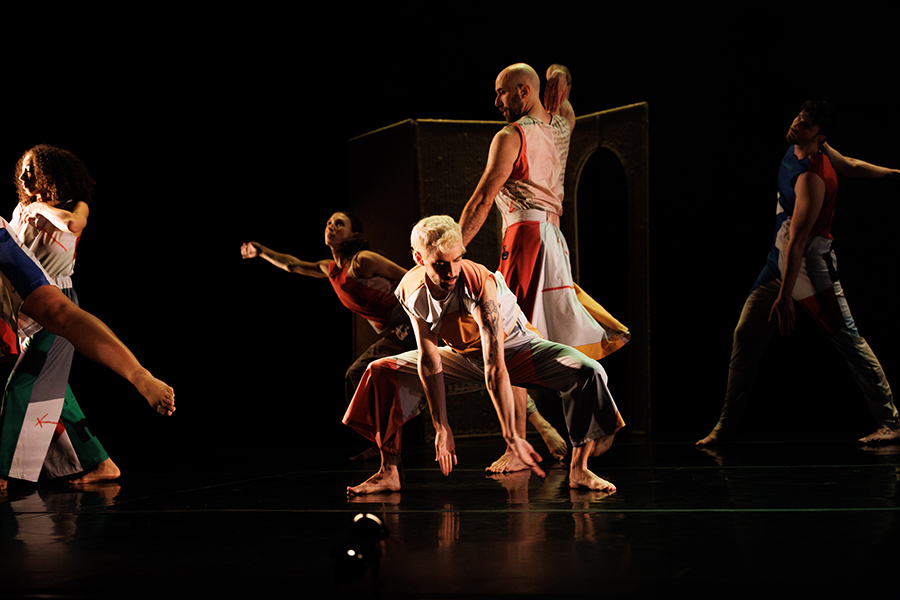
Ahora, en Time again, ambos profundizaron en la idea de que cada retorno al pasado ofrece una oportunidad para reinterpretar y remodelar nuestras decisiones. La obra se acompaña de una partitura original del artista sonoro australiano Alisdair Macindoe y presenta un diseño escénico y de vestuario concebido por Mateo López, que vemos muy coherente con su producción desde e dibujo y la instalación. Y, en este sentido, este proyecto reflejó su enfoque característico de transformar dibujos en estructuras tridimensionales que interactúan con el cuerpo en movimiento.
In Time Again, the two artists delve deeper into the idea that each return to the past offers an opportunity to reinterpret and reshape our decisions. The piece is accompanied by an original score by Australian sound artist Alisdair Macindoe and features stage and costume design conceived by Mateo López—an approach that resonates strongly with his ongoing practice in drawing and installation. In this sense, the project reflects his distinctive approach of transforming drawings into three-dimensional structures that interact with the moving body.

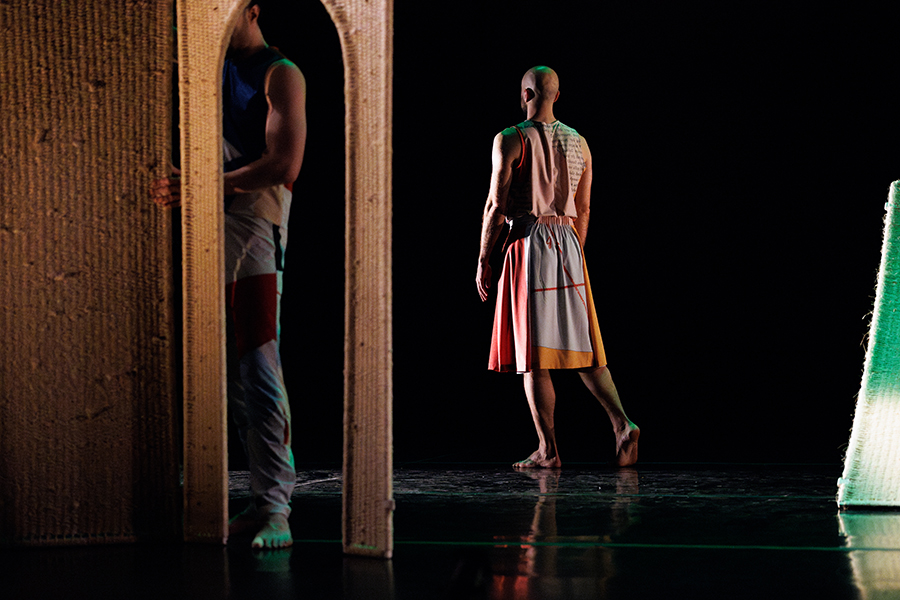
Esta colaboración destaca la importancia de las iniciativas que fomentan el intercambio creativo entre artistas de diferentes disciplinas y culturas, subrayando el papel del arte como puente entre experiencias y perspectivas diversas. Entrevista por Úrsula Ochoa.
This collaboration highlights the importance of initiatives that foster creative exchange between artists from different disciplines and cultures, underscoring the role of art as a bridge between diverse experiences and perspectives. Interview by Úrsula Ochoa.
Úrsula Ochoa: ¿Cómo fue la experiencia de colaborar en la realización de esta obra importante? ¿Ya habías realizado esta clase de trabajos antes?
Mateo López: Fue una experiencia muy bonita trabajar con Lee, con quien ya vengo colaborando desde hace varios años. Es un camino que yo ya venía explorando en mi trabajo: el dibujo que se convierte en objeto, en escultura, y entra en el espacio expositivo, en el espacio tridimensional. Esa es la dirección que he querido darle a mi investigación: entender el dibujo como escultura, como objeto que entra en relación con el cuerpo. El cuerpo, a su vez, se vincula con el arte, con el objeto artístico, activándolo y dándole vida. Curiosamente, en los últimos proyectos estas relaciones se han dado a través de colaboraciones con bailarines, algo que me interesa mucho. Es ese intento de llevar el dibujo a otros escenarios, como la arquitectura, el teatro y la danza. Ese es el camino que estoy siguiendo, uno más cercano a las artes escénicas.
Úrsula Ochoa:What was your experience like collaborating on the creation of this important work? Had you done this kind of work before?
Mateo López: It was a very special experience working with Lee, with whom I’ve been collaborating for several years now. It’s a path I had already been exploring in my practice: drawing that becomes object, becomes sculpture, and enters the exhibition space—the three-dimensional space. That’s the direction I’ve wanted to take this research in: thinking of drawing as sculpture, as an object that engages with the body. The body, in turn, relates to the artwork, to the art object, activating it and bringing it to life. Interestingly, my recent projects have involved collaborations with dancers, which is something I find deeply engaging. It’s part of this attempt to take drawing into other realms—architecture, theater, and dance. That’s the direction I’m moving in, toward something closer to the performing arts.
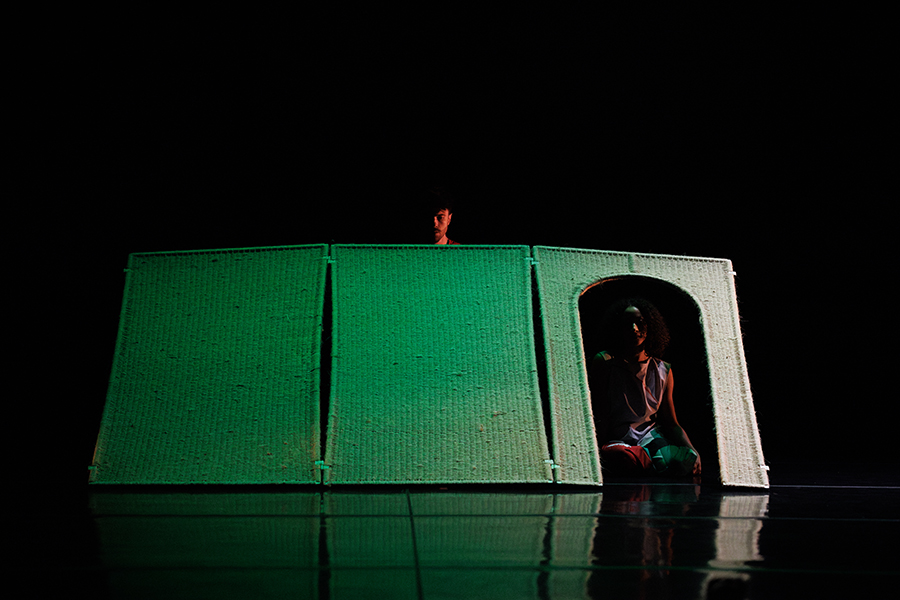
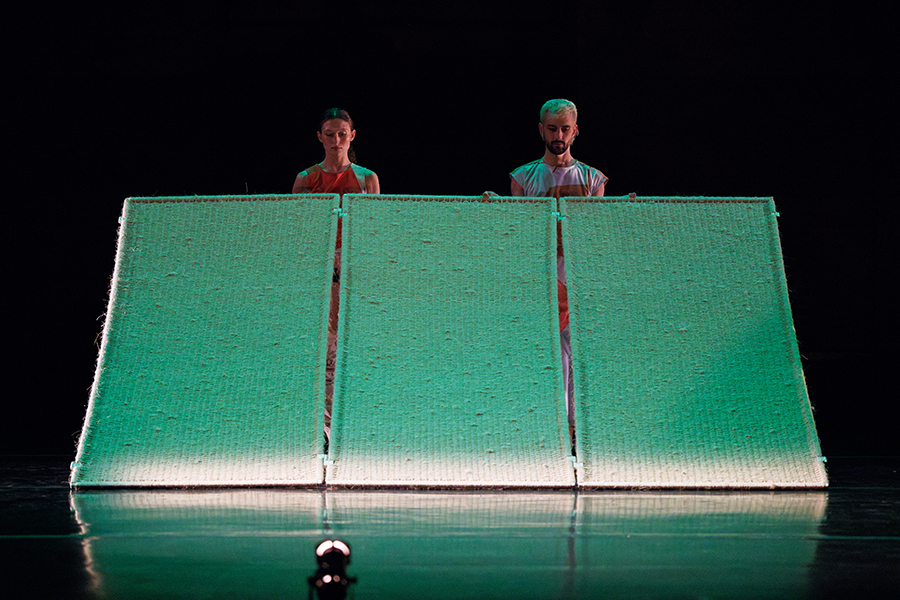
U.O. ¿Hubo algún reto que debiste superar especialmente para realizar este proyecto?
M.L. Siempre hay retos, sobre todo al trabajar a distancia. Lee estaba en Australia y todo lo preparamos a través de conversaciones y videollamadas, así que llevar finalmente la producción implicó retos logísticos, especialmente en cuanto al transporte desde Colombia hasta Nueva York. Tuvimos que pensar en una escultura que fuera fácil de transportar, de guardar y de manipular al usarse como escenografía. Entonces surgieron una serie de requerimientos: materiales livianos, muy suaves, blandos, que no fueran agresivos para el cuerpo. Esos son aspectos técnicos que a mí me interesa mucho explorar.
Los materiales tienen mucho que decir. Por ejemplo, los marcos que están tejidos y que se convierten en una especie de arquitectura o escultura —que yo llamo Bohío— están hechos en cabuya, una fibra que proviene del fique. El fique lo he venido incorporando en mi trabajo desde hace algunos años. Me interesa mucho que los materiales cuenten la historia, porque la materialidad es fundamental en la construcción del arte. Últimamente, incluso diría que me interesa más que el concepto en sí.
U.O. Was there any particular challenge you had to overcome in order to carry out this project?
M.L. There are always challenges, especially when working remotely. Lee was in Australia, and we prepared everything through conversations and video calls, so bringing the production together ultimately involved logistical challenges—particularly in terms of transporting everything from Colombia to New York. We had to think of a sculpture that would be easy to transport, store, and manipulate when used as scenography. That led to a series of requirements: lightweight materials, very soft and flexible, non-aggressive to the body. These are technical aspects that I’m very interested in exploring.
Materials have a lot to say. For example, the frames, which are woven and become a kind of architecture or sculpture—what I call Bohío—are made of cabuya, a fiber that comes from fique. I’ve been incorporating fique into my work for several years now. I’m very drawn to the idea that materials tell stories, because materiality is fundamental to the making of art. Lately, I would even say that it interests me more than the concept itself.
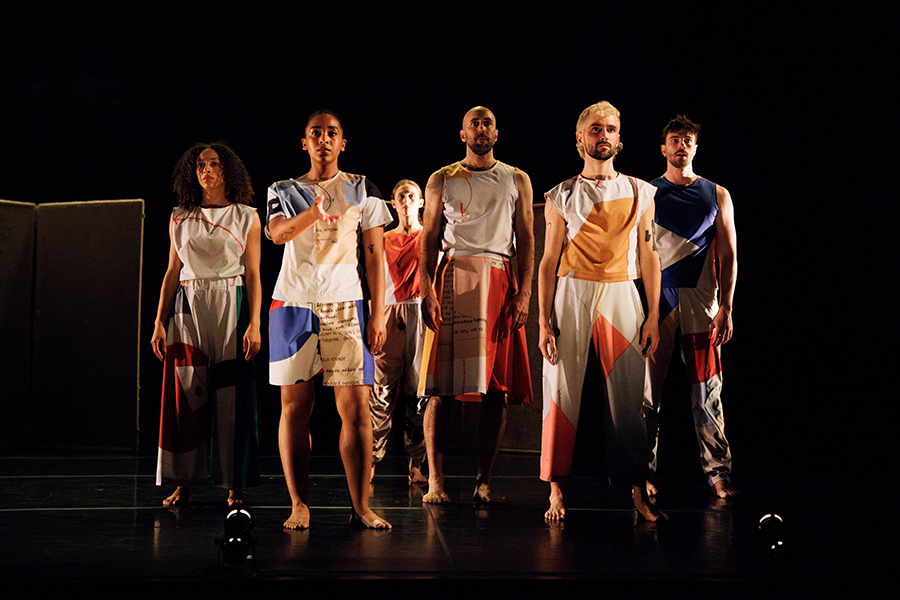
Continúa… M.L. Otro reto importante es cómo introducir estas narrativas en las que el oficio del arte también está ligado a la materialidad, a la manualidad, a lo artesanal. Ese es el contexto en el que vivimos, y una de las cosas más ricas que tiene Colombia. Introducir esa sensibilidad en un contexto tan industrial como el de Estados Unidos —donde todo es rápido y desechable, donde la escenografía se usa, se destruye y se desecha— es un desafío.
Para Lee también fue un reto crear un diálogo, innovar, incorporar un nuevo elemento: una escultura, unos trajes, junto a alguien que no necesariamente habla inglés y viene de otro contexto, con otro tipo de información. Pero al final fue un trabajo muy bonito, y para mí se abren caminos sobre cómo pensar el dibujo en otros contextos.
Continues… M.L. Another important challenge is how to introduce narratives where the craft of art is also linked to materiality, manual work, and the artisanal. That’s the context we live in, and one of the richest aspects of Colombia. Bringing that sensitivity into such an industrialized context as the United States—where everything moves fast and is disposable, where set pieces are used, torn down, and discarded—is a real challenge.
For Lee, it was also a challenge to create a dialogue, to innovate, to incorporate a new element: a sculpture, costumes—while working with someone who doesn’t necessarily speak English and comes from a different context, with a different kind of knowledge. But in the end, it was a very beautiful collaboration, and it opened up new pathways for me in terms of how to think about drawing in other contexts.

